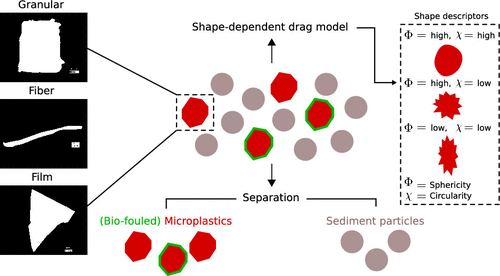当前位置:
X-MOL 学术
›
Environ. Sci. Technol.
›
论文详情
Our official English website, www.x-mol.net, welcomes your
feedback! (Note: you will need to create a separate account there.)
Characteristics and Sinking Behavior of Typical Microplastics Including the Potential Effect of Biofouling: Implications for Remediation.
Environmental Science & Technology ( IF 10.8 ) Pub Date : 2020-06-18 , DOI: 10.1021/acs.est.9b07378 Michiel Van Melkebeke 1, 2 , Colin Janssen 1 , Steven De Meester 2
Environmental Science & Technology ( IF 10.8 ) Pub Date : 2020-06-18 , DOI: 10.1021/acs.est.9b07378 Michiel Van Melkebeke 1, 2 , Colin Janssen 1 , Steven De Meester 2
Affiliation

|
Microplastics are ubiquitous pollutants within the marine environment, predominantly (>90%) accumulating in sediments worldwide. Despite the increasing global concern regarding these anthropogenic pollutants, research into the remediation of microplastics is lacking. Here, we examine those characteristics of microplastics that are essential to adequately evaluate potential remediation techniques such as sedimentation and (air) flotation techniques. We analyzed the sinking behavior of typical microplastics originating from real plastic waste samples and identified the best-available drag model to quantitatively describe their sinking behavior. Particle shape is confirmed to be an important parameter strongly affecting the sinking behavior of microplastics. Various common shape descriptors were experimentally evaluated on their ability to appropriately characterize frequently occurring particle shapes of typical microplastics such as spheres, films, and fibers. This study is the first in this field to include film particles in its experimental design, which were found to make up a considerable fraction of marine pollution and are shown to significantly affect the evaluation of shape-dependent drag models. Circularity χ and sphericity Φ are found to be appropriate shape descriptors in this context. We also investigated the effect of biofouling on the polarity of marine plastics and estimated its potential contribution to the settling motion of initially floating microplastics based on density-modification. It is found that biofouling alters the polarity of plastics significantly; this is from (near) hydrophobic (i.e., water contact angles from 70 to 100°) to strong hydrophilic (i.e., water contact angles from 30 to 40°) surfaces, rendering them more difficult to separate from sediment based on polarity as a primary separation factor. Thus, besides providing a better understanding of the fate and behavior of typical marine microplastics, these findings serve as a fundamental stepping-stone to the development of the first large-scale sediment remediation technique for microplastics to address the global microplastic accumulation issue.
中文翻译:

典型的微塑料的特性和下沉行为,包括生物污染的潜在影响:对修复的影响。
微塑料是海洋环境中普遍存在的污染物,主要(> 90%)在全球沉积物中积累。尽管全球越来越关注这些人为污染物,但仍缺乏对微塑料修复的研究。在这里,我们研究了微塑料的那些特征,这些特征对于充分评估潜在的修复技术(例如沉降和(空气)浮选技术)至关重要。我们分析了源自真实塑料废料样品的典型微塑料的下沉行为,并确定了最佳可用的阻力模型来定量描述其下沉行为。颗粒形状被证实是一个重要的参数,强烈影响着微塑料的下沉行为。通过实验评估了各种常见形状描述符,以恰当地表征典型的微塑料(例如球体,薄膜和纤维)经常出现的颗粒形状。这项研究是本领域中第一个在其实验设计中包含薄膜颗粒的研究,发现该薄膜颗粒构成了相当一部分海洋污染,并且被证明会显着影响形状依赖性阻力模型的评估。在这种情况下,发现圆形度χ和球形度Φ是合适的形状描述符。我们还研究了生物污损对海洋塑料极性的影响,并基于密度修正估算了其对最初漂浮的微塑料沉降运动的潜在贡献。发现生物污垢会显着改变塑料的极性。这是从(近)疏水性(即水接触角为70至100°)到强亲水性(即水接触角为30至40°)表面形成的,这使它们更难从极性上将其与沉积物分离分离因子。因此,除了提供对典型海洋微塑料的命运和行为的更好理解之外,这些发现还为开发首个大规模用于微塑料的沉积物修复技术以解决全球微塑料蓄积问题奠定了基础。
更新日期:2020-07-21
中文翻译:

典型的微塑料的特性和下沉行为,包括生物污染的潜在影响:对修复的影响。
微塑料是海洋环境中普遍存在的污染物,主要(> 90%)在全球沉积物中积累。尽管全球越来越关注这些人为污染物,但仍缺乏对微塑料修复的研究。在这里,我们研究了微塑料的那些特征,这些特征对于充分评估潜在的修复技术(例如沉降和(空气)浮选技术)至关重要。我们分析了源自真实塑料废料样品的典型微塑料的下沉行为,并确定了最佳可用的阻力模型来定量描述其下沉行为。颗粒形状被证实是一个重要的参数,强烈影响着微塑料的下沉行为。通过实验评估了各种常见形状描述符,以恰当地表征典型的微塑料(例如球体,薄膜和纤维)经常出现的颗粒形状。这项研究是本领域中第一个在其实验设计中包含薄膜颗粒的研究,发现该薄膜颗粒构成了相当一部分海洋污染,并且被证明会显着影响形状依赖性阻力模型的评估。在这种情况下,发现圆形度χ和球形度Φ是合适的形状描述符。我们还研究了生物污损对海洋塑料极性的影响,并基于密度修正估算了其对最初漂浮的微塑料沉降运动的潜在贡献。发现生物污垢会显着改变塑料的极性。这是从(近)疏水性(即水接触角为70至100°)到强亲水性(即水接触角为30至40°)表面形成的,这使它们更难从极性上将其与沉积物分离分离因子。因此,除了提供对典型海洋微塑料的命运和行为的更好理解之外,这些发现还为开发首个大规模用于微塑料的沉积物修复技术以解决全球微塑料蓄积问题奠定了基础。











































 京公网安备 11010802027423号
京公网安备 11010802027423号